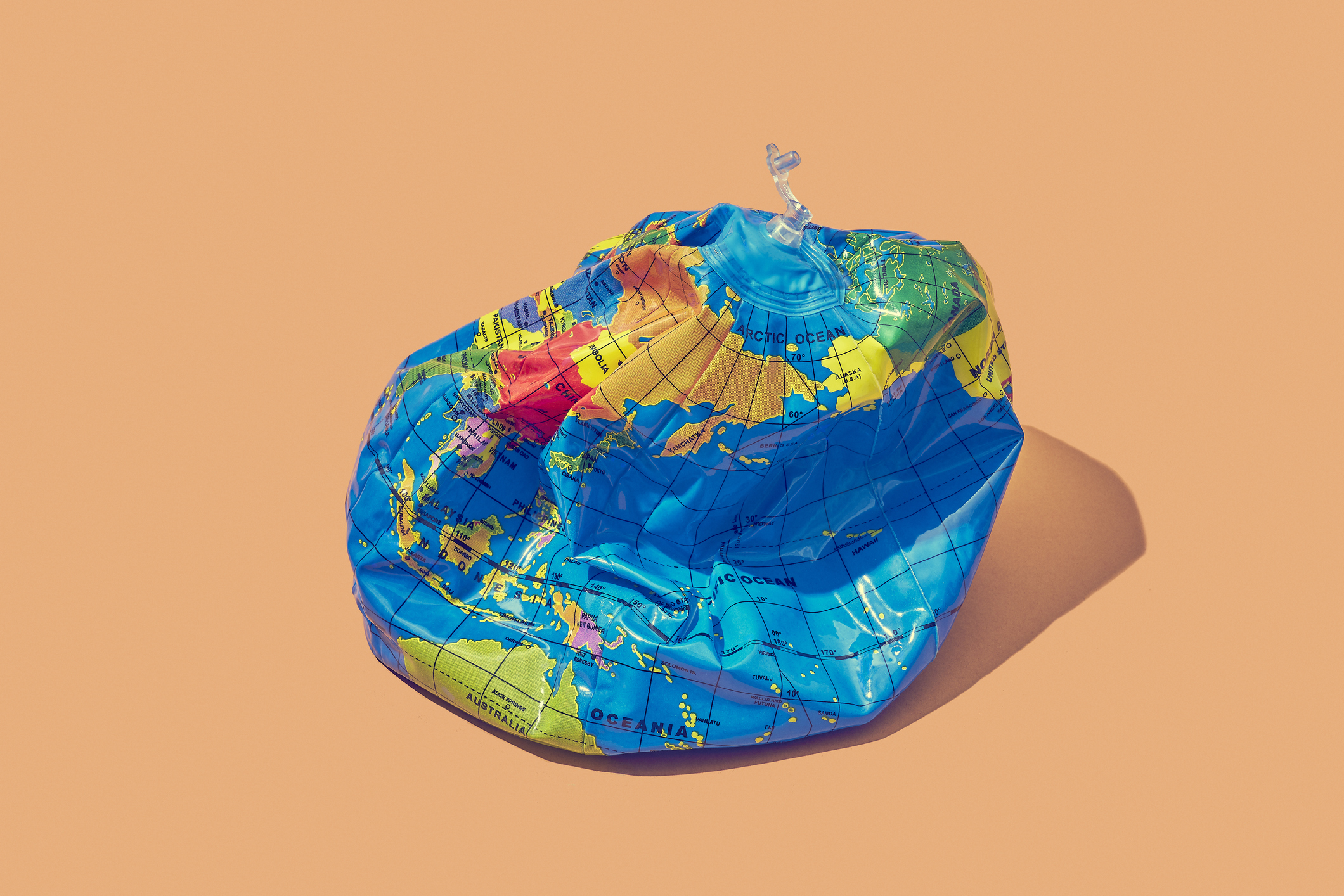High Inflation, Slowing Growth Raise Risk Of Global Downturn
Yellen cites ‘stagflationary effects’ in a warning ahead of a meeting of leaders of seven wealthy nations.
The global economy is in danger of entering a period of so-called stagflation, or high inflation and weak growth, policy makers and corporate leaders say, which could erode living standards around the world.
United States Treasury Secretary Janet Yellen on Wednesday became the latest leader to warn of turbulence for the global economy. “Certainly the economic outlook globally is challenging and uncertain,” Ms. Yellen said in Bonn, Germany, ahead of a meeting of leaders of seven wealthy nations. “Higher food and energy prices are having stagflationary effects, namely, depressing output and spending and raising inflation all around the world.”
Growing fears of high inflation rippled through financial markets Wednesday after large retailers reported disappointing earnings due in part to their own higher costs. The Dow Jones Industrial Average fell more than 1,164 points, or 3.6%, as of 4 p.m. ET in its worst day since 2020. The tech-heavy Nasdaq fell more than 4%. Target Corp. shares sank 25%, putting the company on track for its largest single-day percentage decline since 1987.
Ms. Yellen—a former Federal Reserve chairwoman—indicated that inflation, particularly the rising cost of food and energy, is becoming a greater longer-term concern and will be a dominant theme among global leaders in the weeks and months ahead. She added that the strong U.S. economy could help buffer it from the threat.
“The United States in many ways is best positioned, I think, to meet this challenge, given the strength of our labour market and the economy,” Ms. Yellen said.
A day earlier, Fed Chairman Jerome Powell warned that “there could be some pain involved” in the U.S. as the central bank moves to raise interest rates further to tamp down high inflation.
Meanwhile, Wells Fargo & Co. CEO Charlie Scharf said this week there was no question that the U.S. is headed for an economic downturn. “It’s going to be hard to avoid some kind of recession,” Mr. Scharf said Tuesday at The Wall Street Journal’s Future of Everything Festival.
Earlier this week, Ben Bernanke, also a former Fed leader, raised the possibility of stagflation in an interview published in the New York Times. “Even under the benign scenario, we should have a slowing economy,” he said. “And inflation’s still too high but coming down. So there should be a period in the next year or two where growth is low, unemployment is at least up a little bit and inflation is still high.”
Mr. Bernanke wasn’t available to comment, a spokeswoman said.
Inflation fears have risen in recent days because of new pressures that could further push up prices for oil and food from already-high levels. The European Union this week released a plan aimed at ending its dependence on Russian energy within five years. Rising food prices—also linked to Russia’s invasion of Ukraine, a major global producer of crops—are triggering shortages across the developing world. The U.K. government reported this week that inflation hit a 40-year high of 9% in April. That eclipsed inflation in the U.S., which hit 8.3% in April.
Meanwhile, economists have cut their forecasts for global economic growth this year as China and Europe show signs of a slowdown. China reported this week that consumer spending and output fell sharply in April as the government imposed new lockdowns to stem a wave of Covid-19 infections.
Last month, the International Monetary Fund said it sees the world’s economy expanding 3.6% this year, down from 6.1% last year. The most recent forecast was 0.8 percentage point lower than its projection in January and a 1.3 point cut from its October 2021 outlook.
The Bank of England earlier this month warned that the U.K. was likely to enter a recession.
One big factor behind the darkening outlook is signs from the Fed and the European Central Bank of a more hawkish stance to aggressively tackle inflation. The Fed last month raised interest rates by a half-percentage point—the biggest increase since 2000—and is planning additional increases this year.
ECB President Christine Lagarde indicated this month that she would support raising the central bank’s main interest rate in July, which would mark the first such increase in more than a decade. Higher interest rates mean that the cost of borrowing—for homes, cars, business expansions and other items—would go up, and could ultimately force consumers and firms to cut back, slowing inflation but also economic growth.
Even if the global economy avoids recession, many people could feel like they are in one, economists say. With the cost of living rising faster than most workers’ paychecks, consumers are getting less and less for each dollar they spend. Five dollars spent at the local cafe might get them a medium coffee instead of a large, for instance. Three hundred dollars spent on airfare might get someone from San Francisco to Denver, but not to Chicago.
Americans accumulated savings during the pandemic, as many reduced expenses and received government stimulus. That is now reversing. The saving rate fell in March to the lowest in nine years, according to the Commerce Department. Households are increasingly pulling out their credit cards and spending down their savings to keep up. Americans’ debt loads rose quickly in the year through March after stalling earlier in the pandemic, the latest Fed data show. As interest rates rise, monthly payments on that debt would further eat into household finances, economists say.
For now, the fundamentals of the U.S. economy are solid, with households still in a strong position financially as more people get jobs and return to old habits like travelling, dining out and going to concerts. Sales at American retailers—a big chunk of consumer spending, the biggest source of economic activity in the U.S.—rose in April for the fourth straight month, the Commerce Department said this week.
April’s unemployment rate of 3.6% remained just a shade above the 50-year low set just before the pandemic. Job openings across the U.S. reached a record high of 11.5 million in March.
But the risk of a recession has risen in recent weeks, and certain problems—such as supply chains disrupted by Covid-19 lockdowns in China and the Ukraine war—could be largely beyond the ability of central banks to address.
Diane Swonk, chief economist at the consulting firm Grant Thornton LLP, said one risk is that persistently high inflation would ultimately cause consumers to cut spending and businesses to slow hiring to maintain profit margins. If that happens, there would, for a period at least, be high inflation and rising unemployment—a combination generally known as stagflation that defined the 1970s, when oil shocks, high federal spending and loose monetary policy caused inflation to soar.
Unemployment could rise, as could homelessness, Ms. Swonk said. People could be forced to move in with parents and relatives and do away with healthcare, not to mention vacations and dinner outings.
“Inflation erodes living standards, and especially the kind of inflation we’re talking about—of basic needs—food and shelter and energy, the three pillars of existence,” Ms. Swonk said. “That kind of inflation is an incredible threat to the economy. We’re talking about a humanitarian crisis on top of what’s already been a pandemic and a war in continental Europe.”
Reprinted by permission of The Wall Street Journal, Copyright 2021 Dow Jones & Company. Inc. All Rights Reserved Worldwide. Original date of publication: May 18, 2022.
 Copyright 2020, Dow Jones & Company, Inc. All Rights Reserved Worldwide. LEARN MORE
Copyright 2020, Dow Jones & Company, Inc. All Rights Reserved Worldwide. LEARN MORE
This stylish family home combines a classic palette and finishes with a flexible floorplan
Just 55 minutes from Sydney, make this your creative getaway located in the majestic Hawkesbury region.
Continued stagflation and cost of living pressures are causing couples to think twice about starting a family, new data has revealed, with long term impacts expected
Australia is in the midst of a ‘baby recession’ with preliminary estimates showing the number of births in 2023 fell by more than four percent to the lowest level since 2006, according to KPMG. The consultancy firm says this reflects the impact of cost-of-living pressures on the feasibility of younger Australians starting a family.
KPMG estimates that 289,100 babies were born in 2023. This compares to 300,684 babies in 2022 and 309,996 in 2021, according to the Australian Bureau of Statistics (ABS). KPMG urban economist Terry Rawnsley said weak economic growth often leads to a reduced number of births. In 2023, ABS data shows gross domestic product (GDP) fell to 1.5 percent. Despite the population growing by 2.5 percent in 2023, GDP on a per capita basis went into negative territory, down one percent over the 12 months.
“Birth rates provide insight into long-term population growth as well as the current confidence of Australian families,” said Mr Rawnsley. “We haven’t seen such a sharp drop in births in Australia since the period of economic stagflation in the 1970s, which coincided with the initial widespread adoption of the contraceptive pill.”
Mr Rawnsley said many Australian couples delayed starting a family while the pandemic played out in 2020. The number of births fell from 305,832 in 2019 to 294,369 in 2020. Then in 2021, strong employment and vast amounts of stimulus money, along with high household savings due to lockdowns, gave couples better financial means to have a baby. This led to a rebound in births.
However, the re-opening of the global economy in 2022 led to soaring inflation. By the start of 2023, the Australian consumer price index (CPI) had risen to its highest level since 1990 at 7.8 percent per annum. By that stage, the Reserve Bank had already commenced an aggressive rate-hiking strategy to fight inflation and had raised the cash rate every month between May and December 2022.
Five more rate hikes during 2023 put further pressure on couples with mortgages and put the brakes on family formation. “This combination of the pandemic and rapid economic changes explains the spike and subsequent sharp decline in birth rates we have observed over the past four years,” Mr Rawnsley said.
The impact of high costs of living on couples’ decision to have a baby is highlighted in births data for the capital cities. KPMG estimates there were 60,860 births in Sydney in 2023, down 8.6 percent from 2019. There were 56,270 births in Melbourne, down 7.3 percent. In Perth, there were 25,020 births, down 6 percent, while in Brisbane there were 30,250 births, down 4.3 percent. Canberra was the only capital city where there was no fall in the number of births in 2023 compared to 2019.
“CPI growth in Canberra has been slightly subdued compared to that in other major cities, and the economic outlook has remained strong,” Mr Rawnsley said. “This means families have not been hurting as much as those in other capital cities, and in turn, we’ve seen a stabilisation of births in the ACT.”
This stylish family home combines a classic palette and finishes with a flexible floorplan
Just 55 minutes from Sydney, make this your creative getaway located in the majestic Hawkesbury region.






















